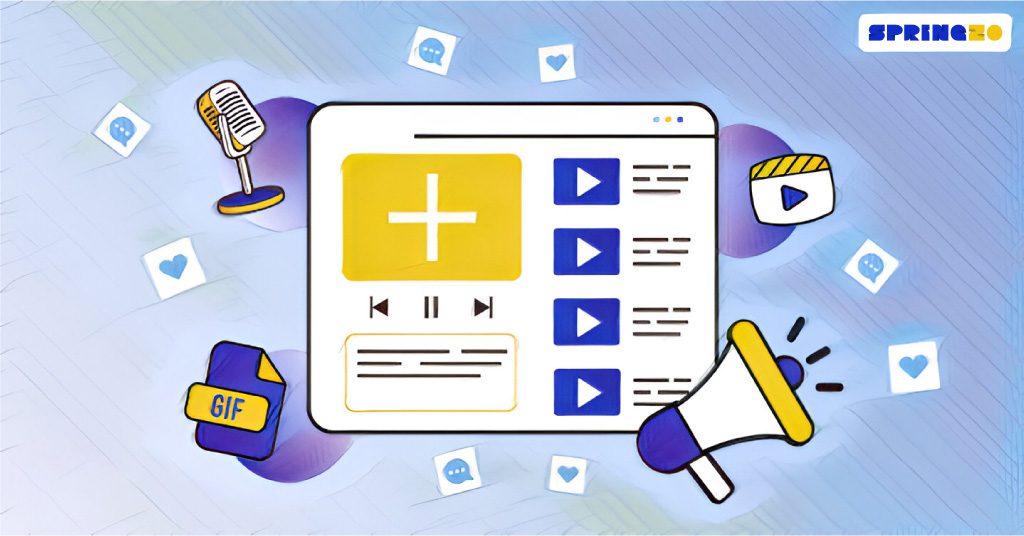According to a study by Referral Rock, 31% of marketers picked video as the winning way to repurpose content. This is because the video format is a great tool for engaging and appealing to a wide range of audiences.
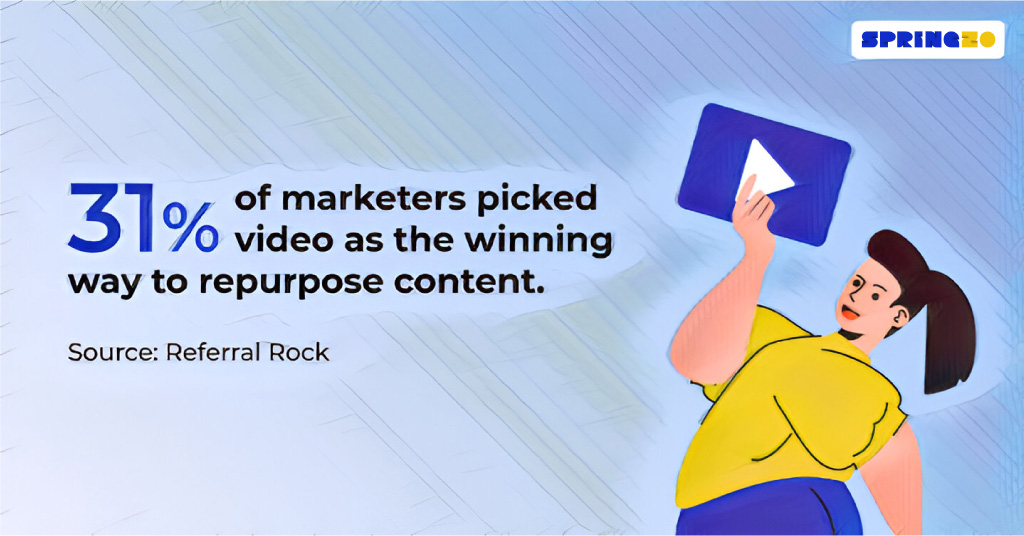
Therefore, it is no wonder that the race is always on for the next viral video. However, before creating something new, have you considered the effort, time, and resources you need to invest? The constant race to produce fresh, captivating material is undoubtedly challenging in the long run.
However, there is an effective shortcut to make this process easier for you: it is to repurpose video content. Due to its many benefits, this strategy has become a secret weapon for many content creators and businesses. Instead of starting over, you can reuse existing video content to craft new narratives or cater to different platforms.
In this comprehensive guide, let us dive into 10 unique methods and some top-notch tools to repurpose video content and achieve your business goals.
Repurposing Video Content: The Concept
More than Recycling
Repurposing isn’t merely about recycling; it’s a strategic maneuver in content creation. Repurpose video content means taking existing video footage and adapting, reshaping, or reframing it to serve a different purpose, audience, or platform without starting from scratch.
The strategy of repurposing video content can be as simple as trimming full-length seminar footage to highlight its key points for a social media clip or as complex as remixing segments from multiple videos to prepare an impactful narrative.
Combining Efficiency and Creativity for Maximum ROI
At the heart of the drive to repurpose video content lies a blend of efficiency and creativity. From an efficiency standpoint, it maximizes the return on investment (ROI) of the original content production.
On the creative front, repurposing challenges marketers and content creators to view their work through a different lens, sparking innovation and ensuring that the content remains fresh and relevant.
Furthermore, in an age of content saturation, where viewers are bombarded with countless videos daily, familiar yet freshly packaged content can stand out.
6 Major Benefits of Repurposing Video Footage
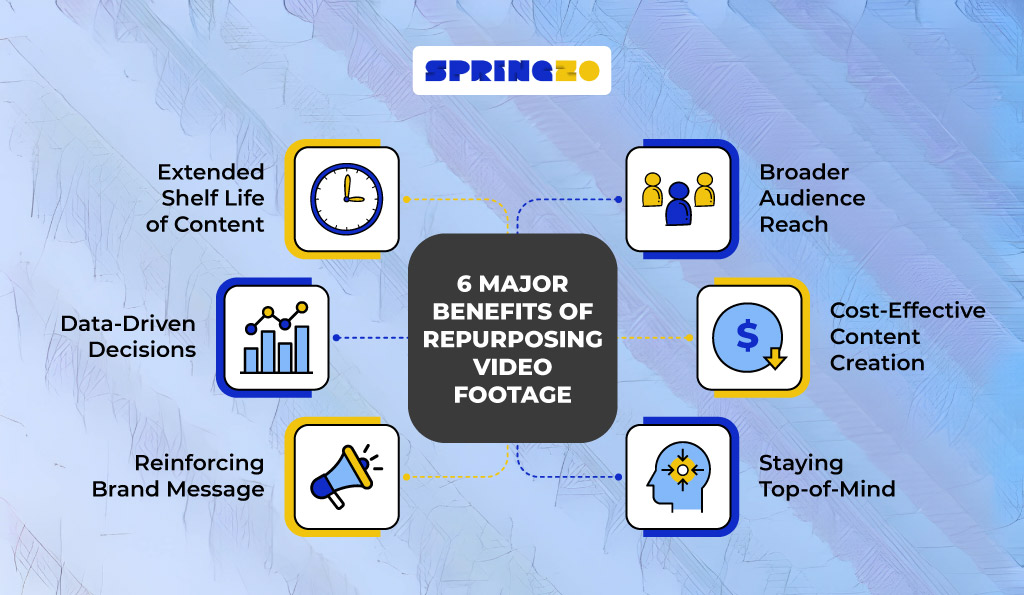
Given the significant investments in original video production – from conceptualization to post-production – it’s crucial to utilize every ounce of value from such efforts. For marketers, businesses, and creators, understanding the multifaceted benefits of repurposing can redefine success metrics and accelerate growth.
Let’s break down why this strategy is a potential game-changer:
1. Extended Shelf Life of Content
Every piece of video content has a lifecycle. By choosing to repurpose video content, its relevance and utility can be extended far beyond its original purpose.
For instance, an annual company event video can be reworked into promotional materials for subsequent years or highlight reels to showcase company milestones.
2. Broader Audience Reach
Different platforms cater to varied demographics and consumption habits. A lengthy webinar, while perfect for a professional platform like LinkedIn, might need short, snappy segments to engage an Instagram audience.
Repurposing allows businesses to tailor their content to diverse platforms and, by extension, wider audiences.
3. Cost-Effective Content Creation
For businesses, especially those operating with tight marketing budgets, the ability to repurpose video content is a cost-saver. Creating fresh content requires not just financial investment but also time and human resources.
Repurposing reduces these burdens, offering a more efficient content-generation method.
4. Staying Top-of-Mind
In a saturated digital space, consistency is key to remaining visible and relevant. Repurposing provides an avenue for businesses and creators to maintain a consistent content cadence, ensuring they remain top-of-mind for their target audiences.
5. Reinforcing Brand Message
Repetition enhances recall. By presenting the same message in diverse formats or across various platforms, businesses can reinforce their brand narrative. This repetition, when done creatively through repurposing, ensures the message is driven home without appearing redundant.
6. Data-Driven Decisions
One overlooked benefit of the repurposed video content strategy is the ability to make more informed decisions. As content is reused across platforms or formats, businesses can gather data on what resonates best with different audiences, refining their content strategy further.
The beauty of choosing to repurpose video content lies in its versatility. It allows brands to continually refresh their content arsenal, meet the evolving needs of their audience, and do so with a touch of innovation.
Remember, the key is to understand the core message of the original content and then mold it in a way that strikes a chord with the new intended audience or platform.
Repurpose Existing Footage: 10 Practical Ways with Examples
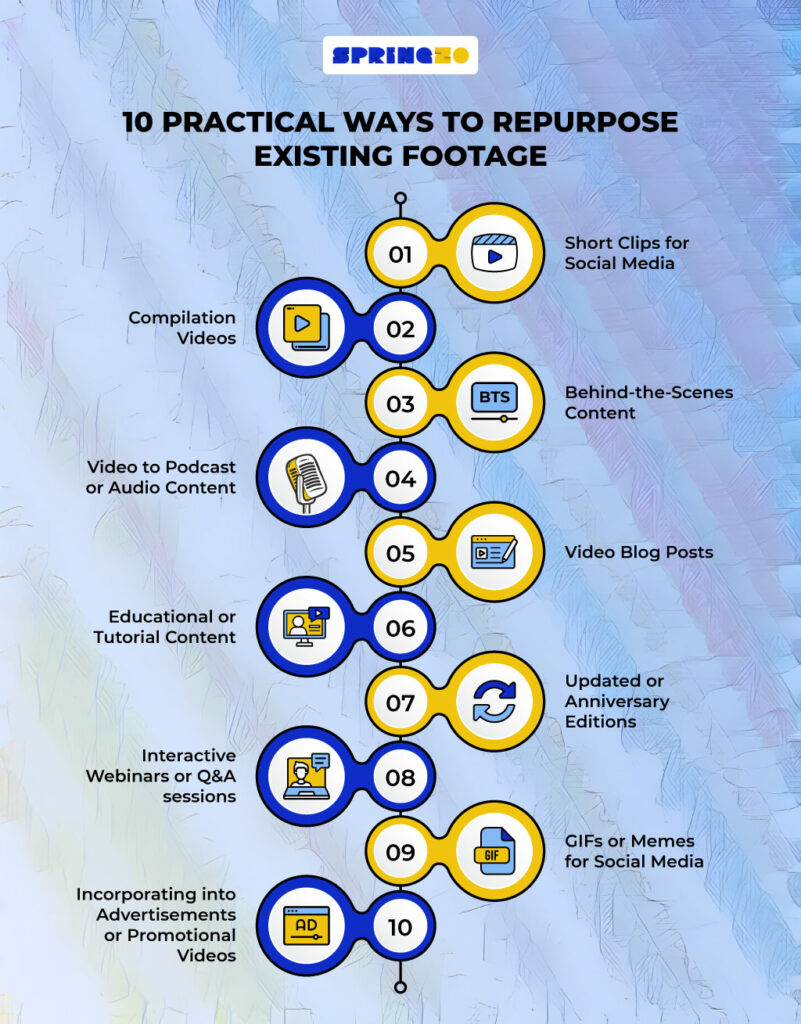
If you’re wondering how to breathe new life into your archived footage, here are ten creative methods accompanied by examples for each:
1. Short Clips for Social Media
Extract impactful, engaging segments from longer content to create bite-sized pieces.
Example: From a 30-minute product demonstration video, extract a 1-minute clip highlighting a standout feature, perfect for sharing on Twitter or Instagram Stories.
2. Compilation Videos
Combine multiple related clips or segments to form thematic videos.
Example: Merge snippets from various customer testimonial videos to create a “What Our Customers Are Saying” compilation for your website’s homepage.
3. Behind-the-Scenes Content
Use cut scenes, bloopers, or preparatory footage to give audiences a more genuine, behind-the-curtain look.
Example: Share candid moments from a product photo shoot, showcasing the effort and fun that goes into the final polished advertisement.
4. Video to Podcast or Audio Content
Strip the audio from your videos to create podcast episodes or other audio-centric content.
Example: Take a series of expert interviews you’ve done on video and repurpose video content into a podcast series, introducing each episode with a brief commentary.
5. Video Blog Posts
Embed videos within written articles, providing a multimedia experience.
Example: Convert a webinar into a blog post, with sections of text elaborating on the video clips embedded throughout the article.
6. Educational or Tutorial Content
Use video snippets to illustrate points or teach procedures clearly.
Example: From a broader video on DIY home renovations, extract segments to create focused tutorials like “How to Install Kitchen Cabinets.”
7. Updated or Anniversary Editions
Refresh old footage with new insights, commentaries, or updates to make it relevant for the present.
Example: On the 5th anniversary of a popular product launch, release the original launch video but with added annotations and commentary on its success over the years.
8. Interactive Webinars or Q&A sessions
Use segments of old footage as reference points or stimuli for live discussions.
Example: During a live Q&A about content marketing, play snippets from past marketing campaigns and discuss the strategy and results in real time.
9. GIFs or Memes for Social Media
Identify moments in your videos that can be transformed into engaging, shareable GIFs or memes.
Example: From a company’s annual retreat video, create a GIF of the CEO’s funny dance move with a caption like “When it’s finally Friday!”
10. Incorporating into Advertisements or Promotional Videos
Weave old footage into new promotional materials to reinforce brand history or evolution.
Example: For a company’s 10th-anniversary promotional video, repurpose video content from past years to showcase the brand’s journey and evolution over the decade.
These strategies ensure that no piece of video content remains inadequately utilized. By continuously finding ways to repurpose, you’re not only maximizing ROI but also ensuring your brand’s message reaches its audience in diverse and impactful ways.
10 Best Tools and Platforms for Repurposing Video Content
In the journey to repurpose video content, having the right tools and platforms at your disposal can make all the difference. These resources not only simplify the process but also elevate the quality and effectiveness of the repurposed material. Let’s delve into some industry-favored tools and platforms essential for anyone looking to masterfully repurpose video content.
1. Adobe Premiere Pro
This industry-standard video editing software offers a suite of advanced tools and features to help editors seamlessly cut, merge, and transform footage.
Best for: Professionals looking for a comprehensive solution to edit and repurpose videos with precision.
2. Canva
While primarily known for graphic design, Canva also offers video editing functionalities, making it easy to create short clips, GIFs, or merge videos.
Best for: Beginners and those looking for a quick way to craft visually appealing repurposed videos without a steep learning curve.
3. Clipchamp
A browser-based video editor that allows for quick edits, compressions, and conversions.
Best for: Those who need lightweight video editing without downloading heavy software.
4. Auphonic
This tool is invaluable when extracting audio from videos. It ensures optimal audio quality, making it perfect for converting videos into podcasts or other audio content.
Best for: Creators aiming to repurpose video content into audio formats while maintaining professional sound quality.
5. Headliner
Headliner is perfect for creating engaging video snippets suitable for social media, complete with captions and waveforms.
Best for: Marketers or creators looking to craft shareable video clips for platforms like Instagram, Twitter, or Facebook.
6. GIPHY
A platform to create and share GIFs. You can upload video snippets and convert them into GIFs in a matter of seconds.
Best for: Those wanting to repurpose video content into fun and engaging GIFs for social media or websites.
7. RePurpose.io
As the name suggests, this platform automates the repurposing process, allowing users to convert a single piece of content into multiple formats.
Best for: Businesses and creators wanting to streamline the repurposing process across various platforms.
8. Anchor
Primarily a podcast platform, Anchor provides tools to convert video files into audio, making it ideal for repurposing video interviews or webinars into podcast episodes.
Best for: Podcasters and creators keen on venturing into the audio space with their existing video content.
9. InVideo
InVideo assists in creating professional-quality videos from existing content, offering templates, text overlays, and more.
Best for: Marketers wanting to quickly craft promotional or ad videos from existing footage.
10. Kapwing
An online platform offering tools for video editing, subtitling, and meme creation, suitable for lightweight edits and quick repurposing tasks.
Best for: Social media managers and creators on the go.
Arming oneself with the right tools is half the battle won. With these platforms and software, the potential to effectively repurpose video content becomes not just a strategy but an art form, ensuring optimal engagement and reach every time the content is reshaped and redelivered.
The Challenges and Solutions of Repurposing Video Content
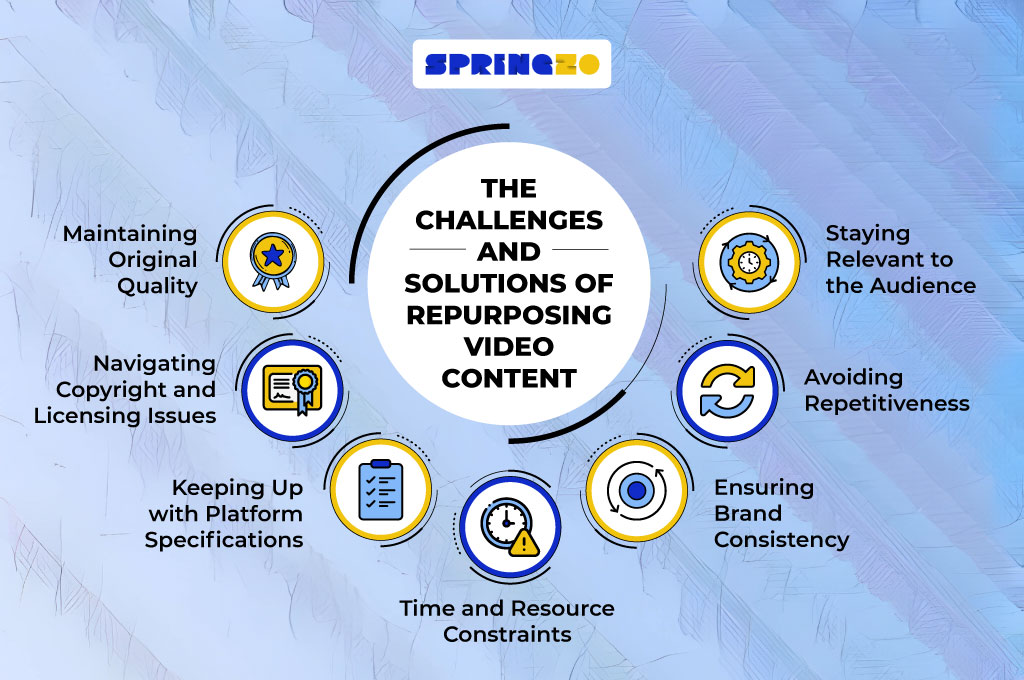
While the strategy to repurpose video content boasts numerous benefits and opportunities, it’s not without its challenges. Understanding these challenges and being equipped with solutions ensures that marketers, creators, and businesses can navigate the repurposing terrain with confidence and effectiveness. Here’s a closer look at some of the common hurdles and ways to overcome them:
1. Maintaining Original Quality
Challenge: When repurposing, especially with multiple edits, compressions, or format changes, the quality of the video can degrade.
Solution: Always work with the highest resolution source file. Utilize software that preserves quality during edits and avoid excessive compressions.
2. Staying Relevant to the Audience
Challenge: Repurposed content might not always resonate with its new target audience if not tailored correctly.
Solution: Thoroughly research platform demographics and preferences. Ensure that when you repurpose video content, it aligns with the interests and behaviors of its intended audience.
3. Avoiding Repetitiveness
Challenge: There’s a fine line between repurposing content and becoming overly repetitive, which can lead to audience fatigue.
Solution: Diversify the ways you repurpose. Incorporate new insights, updated data, or fresh perspectives to keep the content dynamic.
4. Ensuring Brand Consistency
Challenge: Different platforms might necessitate different presentation styles, which can risk diluting the brand’s core messaging or visual identity.
Solution: Even when you repurpose video content, maintain a consistent brand voice, color scheme, and messaging. Use brand guidelines as a touchstone for all repurposed content.
5. Time and Resource Constraints
Challenge: While repurposing is efficient, it still requires time, especially if one aims to do it effectively across multiple platforms.
Solution: Plan ahead and allocate specific resources for repurposing tasks. Use automation tools like RePurpose.io to streamline processes where possible.
6. Keeping Up with Platform Specifications
Challenge: Different platforms have varying specifications for video uploads, such as aspect ratios, durations, and file sizes.
Solution: Stay updated with platform guidelines. Tools like Adobe Premiere Pro and InVideo often have presets for popular platforms, ensuring that repurposed videos always meet specifications.
7. Navigating Copyright and Licensing Issues
Challenge: Using background music, stock footage, or other media elements can lead to copyright concerns, especially when repurposing for different mediums or audiences.
Solution: Always ensure that you have the necessary permissions to use and repurpose video content. If in doubt, opt for royalty-free or licensed resources.
By anticipating these challenges and equipping oneself with proactive solutions, the process of repurposing can remain as efficient and effective as intended, ensuring that content remains impactful no matter its form or destination.
3 Tips for Effective Repurposing
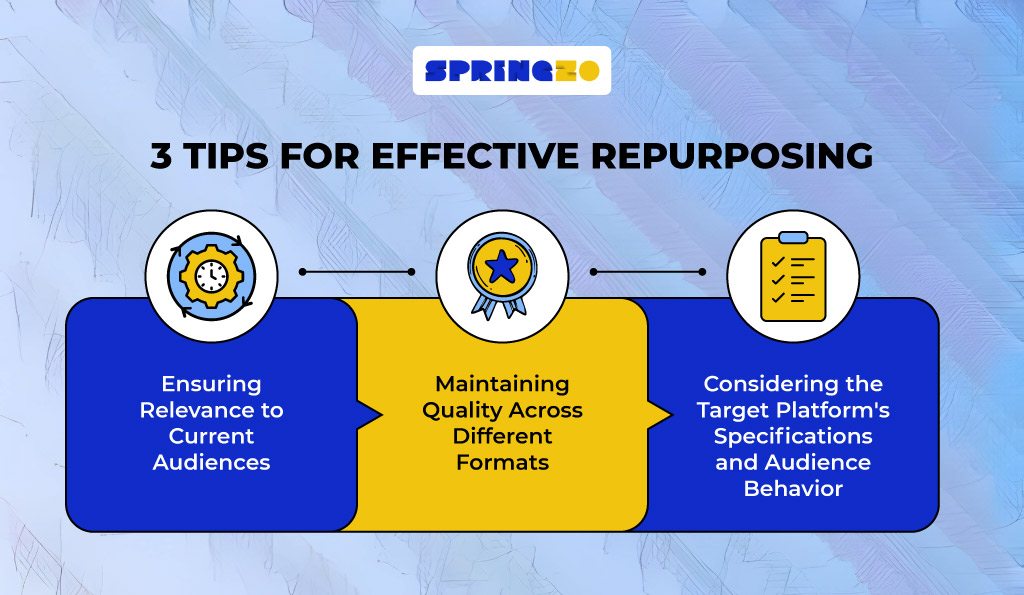
Successfully repurposing content goes beyond just reusing footage—it’s about capturing the essence of your original content and adapting it in a manner that appeals to various audiences and platforms.
Here are some expert tips to ensure your repurposing efforts hit the mark:
1. Ensuring Relevance to Current Audiences
Trends, audience preferences, and global contexts shift. Your repurposed content should reflect the current zeitgeist and speak to what your audience finds valuable now.
Tip: Regularly engage with your audience to understand their evolving needs. Keep an eye on analytics to discern content preferences and adjust your strategy accordingly.
2. Maintaining Quality Across Different Formats
While it’s essential to adapt content for various platforms, the essence and quality of the original content should not be lost in translation.
Tip: Always start with the highest-resolution source file. When converting to new formats, utilize premium tools that ensure minimal loss in quality.
3. Considering the Target Platform’s Specifications and Audience Behavior
Each platform has its unique specifications, algorithms, and audience behavior. Tailoring content to suit these specifics can dramatically boost engagement.
Tip: Stay updated on platform guidelines and trends. Conduct A/B tests to see what format or style works best for each platform. Remember to study your audience’s behavior on these platforms and repurpose content to match their consumption habits.
Rediscovering Your Content’s Potential with Springzo
Today, content is abundant, but what sets brands apart is the ability to continually harness the potential of what they already possess. Your old video library is a goldmine, not just a one-off resource. Each video, clip, or even snapshot can be viewed from a new angle, serving a different purpose and speaking to a fresh audience segment.
At Springzo, we recognize the untapped potential that lies within your existing video library. Repurposing isn’t just a trend; it’s the art of reinventing old content, adapting it to resonate with diverse audiences, and ensuring it aligns with the ever-evolving digital landscape. Our seasoned team is committed to helping marketers, businesses, and creators like you navigate the intricacies of content repurposing with finesse.
Whether you’re on a quest to repurpose video content, transform written assets into compelling visuals, or distill comprehensive narratives into concise, shareable moments, Springzo offers the proficiency, resources, and vision to guide you every step of the way.
Rediscovering and rejuvenating your content arsenal can be a transformative experience, not just for your brand but also for the audiences you serve. With Springzo at your side, you’re not just revisiting content; you’re reinventing narratives and reshaping digital experiences.
Ready to unlock the boundless possibilities of your content? Let Springzo be your compass.
Frequently Asked Questions (FAQs)
1. How frequently should I repurpose my video content?
While there’s no one-size-fits-all answer, it’s advisable to monitor audience engagement and the lifespan of your original content. If the engagement starts waning or if there’s a new trend or context where your content can fit, it might be time to repurpose. Ideally, businesses might consider revisiting their video libraries every 3-6 months to evaluate repurposing potential.
2. If I have limited resources, which platform should I prioritize for repurposing video content?
It really depends on where your audience spends most of their time. However, generally, platforms like YouTube for long-form content and Instagram for shorter clips are immensely popular. Conducting an audience analysis or survey might help pinpoint which platform will yield the most engagement for your repurposed content.
3. How can I ensure that my repurposed video content doesn’t clash with the new content I’m producing?
Planning is crucial. Maintain a content calendar that outlines both your new content and repurposed content schedules. This will allow you to strategically intersperse repurposed videos among new content, ensuring variety and avoiding redundancy.
4. Is there a risk of my audience recognizing and becoming bored with repurposed content?
If done right, repurposed content should feel fresh and relevant, even if familiar. It’s all about the approach. If you’re merely reposting the same video, then yes, there’s a risk. However, if you’re adapting, updating, and presenting it in a new light or context, the content can resonate anew with your audience. Regularly solicit feedback to gauge their perceptions.
